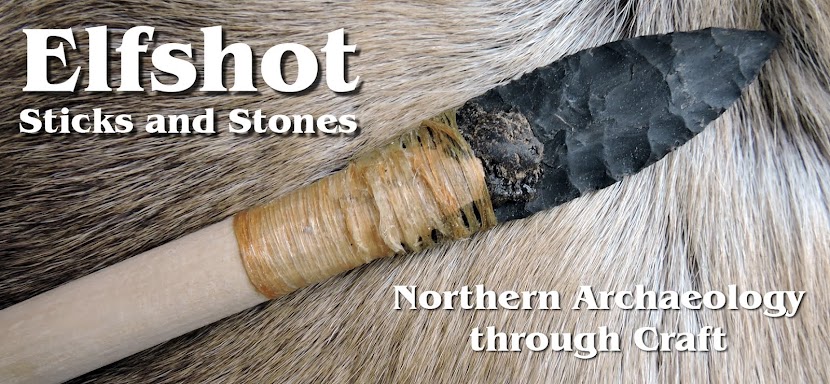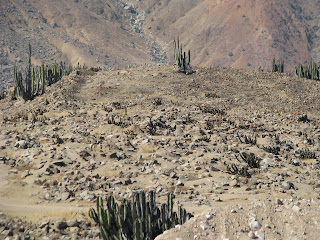I’m the Collections Manager for Archaeology and Ethnology at The Rooms in the Provincial Museum Division. A mouthful, but essentially I look after all of the archaeology collections that have been transferred here after being submitted to the province via the Provincial Archaeology Office. I also look after a relatively small Ethnology collection of Innu, Inuit and Mi’kmaq artifacts.
While I've held a number of different positions with the Museum since I started, they've always overlapped in one way or another with collections management. Over the past several years a lot of my work has involved supporting exhibitions here at The Rooms, which means helping to select artifacts and getting them ready to go on display, assisting with text writing and editing, and maintaining the databases that track all of the artifacts used.
Supporting researchers who want to look at the province’s archaeology collection is also a primary function of the position. We've assisted many students from Memorial University as well as hosting researchers from across Canada and beyond. We have a great lab space that allows people to come down and spend a bit of time with the collections.
Finally we also support a number of loans of artifacts for exhibitions throughout the country, and particularly to community museums around the province every summer.
I think I've always enjoyed organizing things and discovering things in boxes. I grew up going to the Royal Ontario Museum and the Ontario Science Centre a lot. I remember really liking the discovery gallery the ROM had in the basement for kids that had all these edukits you could take down and open up. There were animal skeletons, Egyptian hieroglyphics puzzles and other museum behind-the-scenes sort of things. And of course once you were finished you had to pack everything back neatly into the box and return it to the shelves.
As for my adult career path to collections management, I think it started when I took a field school when I was an undergrad at the University of Toronto. I found that I really enjoyed the lab part of archaeology work - cleaning the artifacts, labeling them, organizing them. While there’s something neat about finding that special artifact in the ground, I like being able to see the bigger picture back in the lab. And there’s also discovering artifact gems that didn't make themselves known until they were cleaned.
3) Has your job changed since you originally began working there? How?
 |
The Archaeology and Ethnology lab at The Rooms.
(Don't use the door for scale - its like 10 feet tall) |
I began working at the museum in 1998 when we were The Newfoundland Museum and we were in the old museum building on Duckworth St. In 2005 we opened here at The Rooms. The improved space and facilities made the job a lot easier. We no longer had to squeeze researchers into one room shared with cabinets stacked three high. This is good too since over the past ten years there has been an increase in the number of researchers who come down to look at our collections.
Of course with the improved building came also improved exhibition space which means we’ve been able to get a lot more artifacts out and on display since 2005. I would say that the increased involvement of the collections manager in exhibitions is one of the main ways the job has changed.
4) What’s one thing that you wish archaeologists would do to make your job easier?
Be as organized as you possibly can be.
 |
| Local and international researchers make use of collections. |
This would cover ensuring you’re collecting the right information in the field, making sure your cataloguing is clear and correct and reviewing your collections before you submit them to the Provincial Archaeology Office to ensure all the artifacts are accounted for and the proper documentation accompanies it.
The thing to keep in mind with collections is to think about being someone who opens the boxes of what you have submitted today fifteen years from now. Will it make sense to someone else? Can they read your catalogue numbers? Will they be able to find everything possible about the site? Will they be able to use your work to help answer future questions?
Being as organized as you possibly can be also holds true for coming down to The Rooms to research. Getting in touch with me a week or two at least before you want to do research is good since we do go through busy times when it’s not always possible to arrange something on short notice. As well, the more information you have about what you want to look at, the better I can help get what you need.
5) If you could give your younger self advice at the start of your career, what would it be?
Do what you did.
I was very fortunate to have had the variety of experiences I did. This allowed me to end up with a broad set of skills that lets me do a number of different things easily.
6) Are there skills that you didn't learn in school that are important in your job? What are they?
 |
| The Vaults |
The training I had as a conservator through my Artifact Conservation Techniques program at Sir Sandford Fleming collage, along with the eight month internship I had at the Newfoundland Museum really provided an excellent foundation for this job. This was further complimented by the work I did for my MA at MUN on Labrador Palaeoeskimo collections.
Beyond what I was taught, I would list being organized and being able to pay attention to detail are what is needed in this position – which often can’t be taught so much but are traits people who do this work have.
Computer applications have changed so much over the years. As such, you need to be computer comfortable and learn new programs as they come along and try be open to change as best as possible.
7) How do you unwind when you need to get away from your job?
 |
| Elaine in Spain. (Photo: Lori White) |
I really enjoy travel. I find physically removing myself from my day- to-day environment allows me to completely let go of all work thoughts and allows me to relax - which is something everyone should do, despite how busy things may be! And while some museum and archaeology site visits are fun when on holiday, I equally enjoy just roaming around a city or sitting by the pool with a book and a drink.
8) If you had to pick a fictional character to work as your assistant, who would you pick? Why?
Doctor Who for his insatiable curiosity and for the ability to use The Tardis to time travel and maybe go back and figure out just what the heck *that* artifact is! - While any past Doctor would be good the particularly quirky current Matt Smith version would be a fun one.
9) What books or websites would you recommend if people want to learn more about your field of work in general? Or your job in particular?
 |
| Researcher space in the Lab |
For collections management principles and policies:
Things Great and Small: Collections Management Policies by John E. Simmons, 2005
Collection Conundrums: Solving Collections Management Mysteries, Rebecca Buck and Jean Gilmore Eds., 2007
For basic museum operations and exhibit work:
Museum Basics by Timothy Ambrose and Crispin Paine (Apr 12 2006)
The Manual of Museum Exhibitions By Barry Lord and Gail Dexter Lord, 2002
If you want to view archaeology collections at The Rooms, you can contact me at
eanton@therooms.ca
==============================================
Do you know someone with an interesting job in archaeology? Maybe its you? Let me know:
elfshot.tim@gmail.com.
Photo Credits:
Elaine Anton, unless otherwise noted in the caption
Plans and Profiles banner: Tim Rast, based on a linocut by Lori White


















































